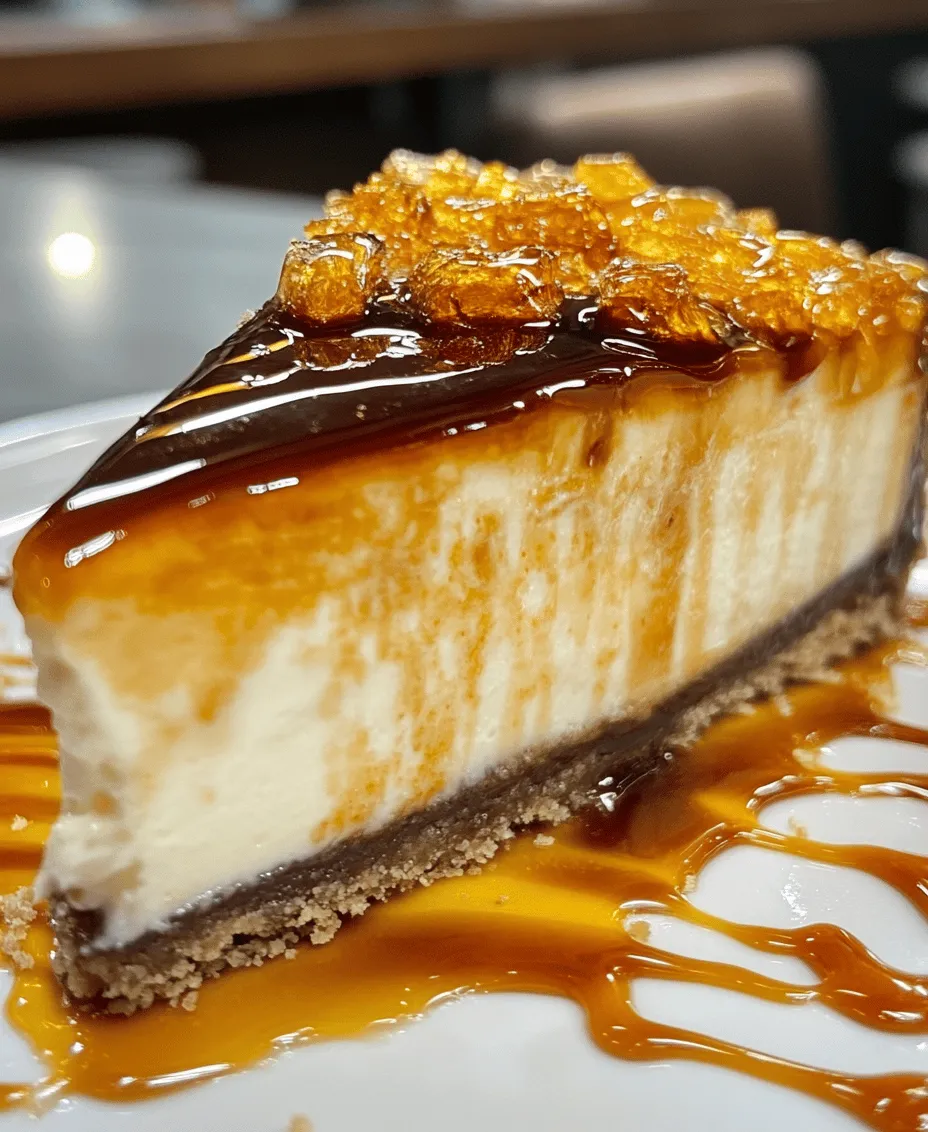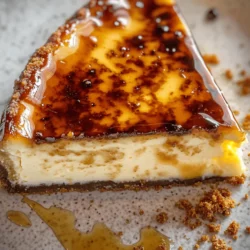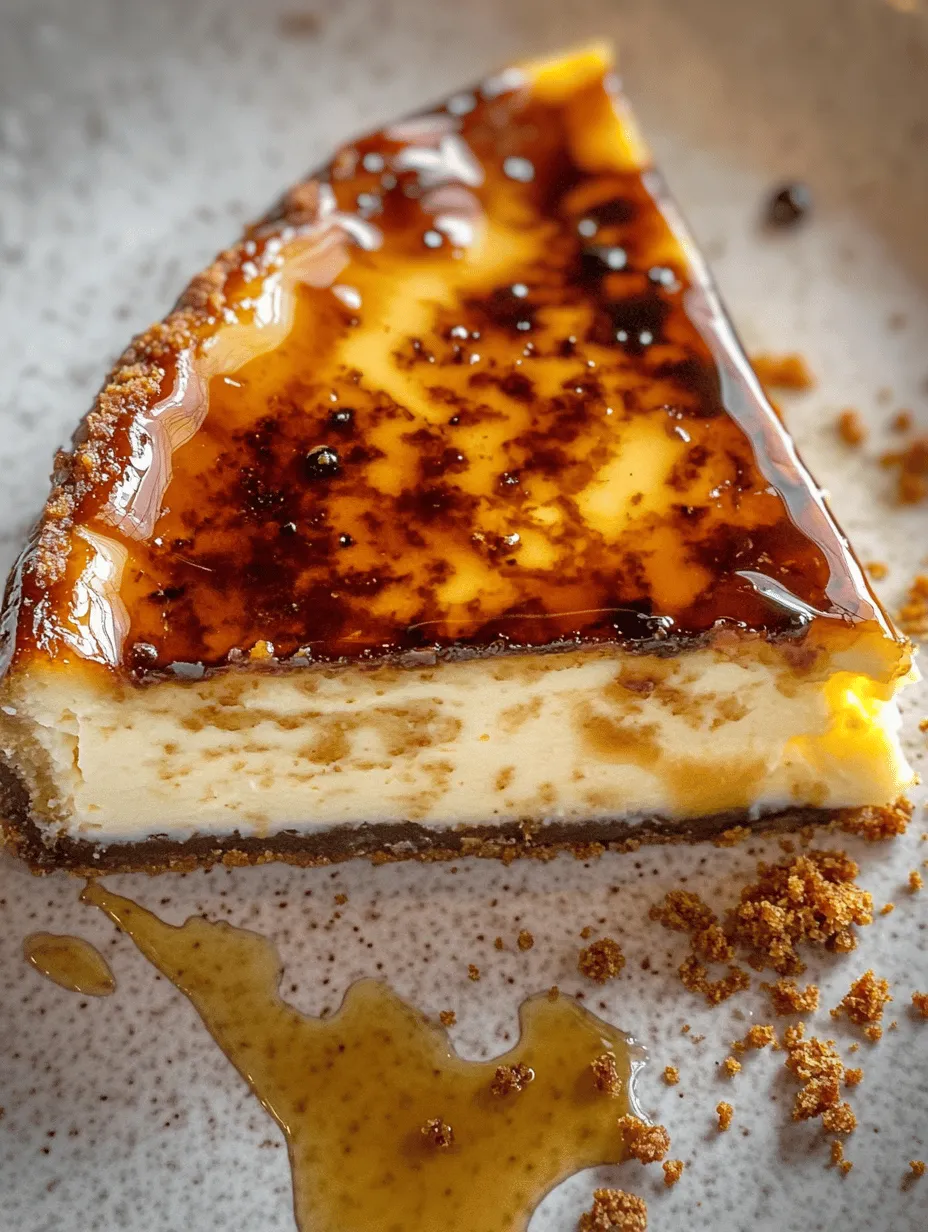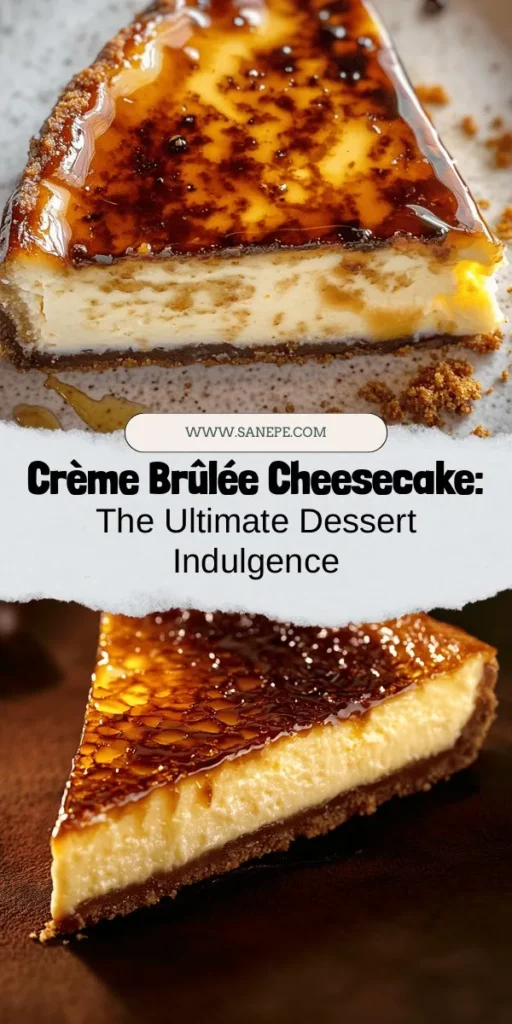Indulging in dessert is a universal pleasure, and few treats can rival the luxurious combination of crème brûlée and cheesecake. This Crème Brûlée Cheesecake Delight encapsulates the rich, creamy texture of cheesecake with the caramelized sugar topping of crème brûlée, creating a decadent dessert that is perfect for special occasions or even as a delightful treat during a cozy night in. The combination of flavors and textures in this dessert provides a sophisticated twist on traditional cheesecake, making it a show-stopping centerpiece for any gathering.
In this article, we will explore the origins of these two beloved desserts, walk through the ingredients and step-by-step instructions to create this masterpiece, and provide insights into the techniques that will ensure your cheesecake turns out flawless every time.
Understanding the Basics of Cheesecake
Exploring the History of Cheesecake
Cheesecake has a rich and varied history that dates back thousands of years. The earliest known recipe for cheesecake comes from ancient Greece, where it was served to athletes during the first Olympic Games in 776 B.C. The Greeks used simple ingredients like cheese, honey, and flour to create a dish that was both nourishing and delicious. This early version of cheesecake made its way to Rome, where it evolved further, incorporating new ingredients and techniques.
Over the centuries, cheesecake has adapted to various cultures, leading to the diverse styles we enjoy today. The modern cheesecake we recognize, particularly in the United States, is often made with cream cheese, sugar, and eggs, resulting in a richer and creamier texture than its ancient predecessors.
Different Styles of Cheesecake Around the World
There are numerous styles of cheesecake around the world, each with its unique characteristics. Some of the most popular include:
– New York-Style Cheesecake: Known for its dense and creamy texture, this cheesecake is made with a generous amount of cream cheese and often includes sour cream or heavy cream for added richness. It is typically baked in a springform pan and has a rich, buttery graham cracker crust.
– Italian Ricotta Cheesecake: This version uses ricotta cheese instead of cream cheese, resulting in a lighter texture. It is often flavored with citrus zest and has a more delicate sweetness.
– Japanese Cotton Cheesecake: Light and airy, this cheesecake is made using a unique method that incorporates whipped egg whites, giving it a soufflé-like texture. It is less sweet than traditional cheesecakes and has a melt-in-your-mouth quality.
– No-Bake Cheesecake: This style is made without baking, relying on the setting properties of gelatin or whipped cream to achieve a firm yet creamy texture. It is often lighter and can be flavored with various fruits or chocolate.
Each of these styles brings something special to the table, but what unites them all is the delightful harmony of flavors and textures that define cheesecake.
Key Components of a Successful Cheesecake
To create the perfect cheesecake, a few key components must be considered:
– Cream Cheese: The primary ingredient in most cheesecakes, it provides the rich, creamy base. Using full-fat cream cheese is essential for achieving the desired texture.
– Sugar: Sugar sweetens the cheesecake and balances the tanginess of the cream cheese. Granulated sugar is commonly used, although some recipes may incorporate powdered sugar for a smoother finish.
– Eggs: Eggs act as a binding agent, providing structure and stability to the cheesecake. They also contribute to the overall richness of the dessert.
– Flavorings: Vanilla extract is a classic addition, but many cheesecakes incorporate other flavorings like lemon zest, chocolate, or fruit purees to enhance the taste.
– Crust: A well-made crust provides a delicious contrast to the creamy filling. Traditional graham cracker crusts are popular, but other options like Oreo or almond flour crusts can also be delicious.
Understanding these components will help you create a cheesecake that not only tastes fantastic but also has the right texture and consistency.
The Allure of Crème Brûlée
A Brief History of Crème Brûlée
Crème brûlée, a quintessential French dessert, translates to “burnt cream” in English and is characterized by its rich custard base topped with a layer of hard caramel. The origins of crème brûlée can be traced back to the 17th century, with competing claims from both France and England regarding its invention. The French version is typically made with cream, egg yolks, sugar, and vanilla, while the English version, known as “Trinity Cream,” is flavored with orange and served with a burnt sugar topping.
Despite its debated origins, crème brûlée has become a staple in French patisserie, admired for its elegant presentation and delightful contrast between the creamy custard and the crunchy caramelized sugar topping.
The Science Behind the Caramelization Process
The process of creating the signature caramelized topping of crème brûlée is a meticulous one that involves heating sugar to a high temperature until it melts and turns golden brown. This transformation, known as caramelization, occurs when sugar molecules break down and recombine, creating complex flavors and a distinct color.
To achieve the perfect caramel crust, it is essential to use granulated sugar and a high heat source, such as a kitchen torch or broiler. The goal is to melt the sugar evenly without burning it, resulting in a crisp layer that contrasts beautifully with the smooth custard below.
Why Crème Brûlée Makes the Perfect Topping for Cheesecake
The marriage of crème brûlée and cheesecake is a match made in dessert heaven. The rich and creamy texture of cheesecake provides the ideal base for the thin layer of caramelized sugar that characterizes crème brûlée. The combination not only offers a delightful contrast in texture but also enhances the overall flavor profile.
The slight bitterness of the caramelized sugar cuts through the richness of the cheesecake, creating a balanced dessert that is both indulgent and satisfying. This Crème Brûlée Cheesecake Delight is sure to impress your guests and elevate your dessert game.
Ingredients Breakdown
To create this exquisite Crème Brûlée Cheesecake Delight, it is essential to gather the right ingredients. Each component plays a crucial role in achieving the desired flavor and texture.
Analyzing the Crust Components
– Graham Crackers: The foundation of the crust, graham crackers provide a sweet and slightly nutty flavor. They are easily crushed to create a crumbly texture that holds together when mixed with butter.
– Butter: Unsalted butter is typically used to bind the graham cracker crumbs together. It adds richness and flavor to the crust.
– Sugar: A small amount of granulated sugar is often added to the crust mixture to enhance its sweetness.
Understanding the Cheesecake Filling Ingredients
– Cream Cheese: Full-fat cream cheese is the star ingredient in the filling, providing a creamy and smooth texture. It is crucial to allow it to come to room temperature before mixing for a lump-free consistency.
– Granulated Sugar: Sugar is essential for sweetening the filling and balancing the tanginess of the cream cheese.
– Eggs: Whole eggs are incorporated into the filling to provide structure and stability. Be sure to use room temperature eggs for better incorporation.
– Sour Cream: Sour cream adds a tangy flavor and contributes to the overall creaminess of the filling. It also helps to keep the cheesecake moist.
– Vanilla Extract: Pure vanilla extract enhances the flavor profile, adding a warm and aromatic note.
Exploring the Crème Brûlée Topping Ingredients
– Granulated Sugar: The topping is made with granulated sugar, which will be caramelized to create the signature hard crust.
– Heavy Cream: Heavy cream is used in the crème brûlée layer, contributing to the luxurious texture and rich flavor.
– Egg Yolks: Egg yolks are essential for creating the custard base for the crème brûlée. They provide richness and a smooth consistency.
– Vanilla Bean or Extract: For an aromatic depth of flavor, either vanilla beans or high-quality vanilla extract can be used in the crème brûlée topping.
Preparing the Crust
The Importance of a Sturdy Crust
A sturdy crust is essential for supporting the weight of the cream cheese filling and the crème brûlée topping. A well-made graham cracker crust should be firm enough to hold its shape but still crumbly enough to provide a pleasant texture contrast.
Step-by-Step Instructions for Making the Graham Cracker Crust
1. Preheat the Oven: Preheat your oven to 350°F (175°C).
2. Crush the Graham Crackers: Place graham crackers in a food processor and pulse until finely crushed. Alternatively, you can place them in a zip-top bag and use a rolling pin to crush them.
3. Mix the Crust Ingredients: In a mixing bowl, combine the crushed graham crackers, granulated sugar, and melted butter. Mix until the crumbs are evenly coated and resemble wet sand.
4. Press into the Pan: Transfer the crumb mixture to a 9-inch springform pan. Using the back of a measuring cup or your fingers, press the crumbs firmly and evenly across the bottom and slightly up the sides of the pan.
5. Bake the Crust: Bake the crust in the preheated oven for 8-10 minutes, or until lightly golden. Remove from the oven and allow it to cool completely while you prepare the cheesecake filling.
Tips for Pressing the Crust Evenly into the Pan
– Ensure that the crumbs are packed tightly and evenly to avoid a crumbly crust after baking.
– If your crust is too dry, add a bit more melted butter to help it hold together better.
– For a more flavorful crust, consider adding a pinch of salt or incorporating crushed nuts into the graham cracker mixture.
Crafting the Cheesecake Filling
Techniques for Achieving the Perfect Cream Cheese Consistency
To craft a smooth and creamy cheesecake filling, follow these techniques:
1. Soften the Cream Cheese: Make sure to bring the cream cheese to room temperature before mixing. This will help achieve a smooth consistency and prevent lumps.
2. Use an Electric Mixer: An electric mixer or stand mixer is recommended for blending the cream cheese with sugar until smooth. Start on a low speed to prevent splattering and gradually increase to medium speed.
3. Add Ingredients Gradually: Incorporate the eggs, sour cream, and vanilla extract one at a time, mixing well after each addition. This ensures that the ingredients are evenly distributed and minimizes the risk of overmixing.
4. Avoid Overmixing: While it is essential to achieve a smooth batter, overmixing can introduce excess air, which may cause the cheesecake to crack during baking. Mix just until combined.
5. Scrape Down the Sides: Periodically scrape down the sides of the mixing bowl to ensure all ingredients are fully combined.
By following these techniques, you’ll create a luscious cheesecake filling that will serve as the perfect base for your Crème Brûlée Cheesecake Delight.
In the next section, we will delve deeper into the preparation of the crème brûlée layer and the final steps to bring this delectable dessert together. Stay tuned for a step-by-step guide that will help you achieve the perfect balance of flavors and textures in your Crème Brûlée Cheesecake Delight.

Incorporating Sugars and Eggs for Optimal Flavor
To achieve the luxurious flavor profile of your Crème Brûlée Cheesecake Delight, the interplay between sugars and eggs is crucial. Begin by ensuring that you use high-quality granulated sugar, which helps to enhance the sweetness without overpowering the delicate balance of flavors within the cheesecake. The sugars not only add sweetness but also contribute to the overall texture by creating a smooth, creamy consistency as they blend with the other ingredients.
When it comes to eggs, they serve multiple purposes in this recipe. They provide structure, moisture, and richness, essential for a cheesecake’s creamy filling. Use large eggs, as they provide the right amount of liquid and fat to create a velvety texture. Whisk the eggs until they are just combined to avoid incorporating too much air, which can lead to cracks in the final product.
The Role of Cornstarch and Heavy Cream in the Texture of the Cheesecake
Cornstarch is often overlooked, but it plays a significant role in achieving the right texture for your cheesecake. It acts as a stabilizer, helping to firm up the filling while ensuring that it retains a smooth and creamy consistency. This is particularly important for a cheesecake that is baked in a water bath, as it helps create a velvety mouthfeel without making the dessert dense.
Heavy cream is another key ingredient that contributes to the cheesecake’s luxurious texture. The rich fat content of heavy cream adds a level of creaminess that is simply unmatched. When combined with the cream cheese, it creates a beautifully rich filling that melts in your mouth. Make sure to use fresh heavy cream for the best results, as it will enhance both the flavor and texture of your dessert.
Baking the Cheesecake
Setting Up the Water Bath for Even Baking
Baking your Crème Brûlée Cheesecake Delight in a water bath (bain-marie) is essential for preventing cracks and ensuring even cooking. Start by wrapping the bottom of your springform pan in aluminum foil to prevent any water from seeping in. Place the wrapped pan into a larger baking dish and fill the outer dish with hot water until it reaches halfway up the sides of the springform pan. This gentle cooking method helps to regulate the temperature and keeps the cheesecake moist.
Proper Baking Times and Temperatures for the Perfect Cheesecake
Preheat your oven to 325°F (160°C). Pour the cheesecake batter into the prepared springform pan and smooth the top with a spatula. Bake for about 50 to 60 minutes, or until the edges are set and the center has a slight jiggle. It’s crucial not to overbake the cheesecake, as it will continue to cook even after being removed from the oven. The ideal texture should be creamy and slightly soft in the center.
Cooling Techniques to Prevent Cracking
Once your cheesecake has finished baking, turn off the oven and crack the door open slightly, allowing the cheesecake to cool gradually. This step is vital for minimizing cracks, as sudden temperature changes can cause the cheesecake to split. Leave it in the oven for about an hour before transferring it to a wire rack to cool completely at room temperature. After it reaches room temperature, refrigerate it for at least four hours, or overnight for the best results.
Creating the Crème Brûlée Topping
The Method for Heating Cream and Extracting Flavor
While your cheesecake cools, you can prepare the Crème Brûlée topping. Start by heating heavy cream in a saucepan over medium heat. If you want to infuse additional flavors, consider adding vanilla beans or citrus zest to the cream. Allow the mixture to come to a simmer, then remove it from the heat. Let it steep for about 15 minutes to extract maximum flavor before straining it to remove any solids.
Whisking Egg Yolks to Achieve the Right Consistency
In a separate bowl, whisk together egg yolks and sugar until the mixture becomes pale and slightly thickened. This process helps to aerate the yolks, creating a rich custard base. It’s important to use only the yolks for this topping, as they provide the creaminess and richness characteristic of Crème Brûlée.
Combining the Hot Cream with the Yolks for a Smooth Topping
Gradually pour the hot cream into the egg yolk mixture while continually whisking to temper the eggs. This technique prevents the yolks from cooking too quickly and scrambling. Once fully combined, pour the mixture back into the saucepan and cook over low heat, stirring constantly until it thickens slightly and coats the back of a spoon. It should reach a temperature of about 170°F (77°C) for optimal thickening without curdling.
Caramelizing the Topping
Broiling vs. Using a Kitchen Torch: Pros and Cons
When it comes to caramelizing the topping, you have two primary methods: broiling in the oven or using a kitchen torch. Broiling is straightforward and can cover a larger surface area at once, but it requires close monitoring to prevent burning. Alternatively, a kitchen torch offers precision and control, allowing you to caramelize specific areas without affecting the rest of the dessert.
Monitoring the Caramelization Process to Avoid Burning
Regardless of the method chosen, keep a close eye on the caramelization process. If using a broiler, place the cheesecake on a baking sheet and adjust the oven rack to ensure the cheesecake is several inches away from the heat source. Watch for the sugar to melt and turn a beautiful golden brown. If using a torch, hold it a few inches from the sugar surface and move it in circular motions to achieve even caramelization.
Tips for Achieving a Perfectly Crispy Top
To ensure a perfectly crispy top, use granulated sugar rather than powdered sugar, as it caramelizes better. Sprinkle an even layer of sugar over the cooled cheesecake, tapping off any excess. If necessary, repeat the caramelization process to achieve your desired level of crispiness. Allow the topping to cool slightly before serving to achieve the perfect crunch.
Final Steps: Chilling and Serving
Understanding the Importance of Chilling for Flavor Development
Chilling your Crème Brûlée Cheesecake Delight is essential for flavor development. The flavors meld and deepen as the cheesecake rests in the refrigerator, allowing the rich cream cheese and caramel notes to shine through. Aim for at least four hours of chilling, but overnight is preferable for the best taste and texture.
Removing the Cheesecake from the Springform Pan Without Damaging It
Once chilled, carefully release the springform pan by unclipping the sides. If necessary, run a knife around the edge to loosen the cheesecake before gently lifting it out. Place it on a serving platter, being cautious to maintain its shape.
Presentation Tips for Serving Your Crème Brûlée Cheesecake Delight
Presentation is key for this show-stopping dessert. Consider garnishing with fresh berries, a sprig of mint, or a drizzle of chocolate sauce for added visual appeal. Serve each slice with a side of whipped cream or additional caramel sauce for an indulgent touch.
Conclusion
The Crème Brûlée Cheesecake Delight is not just a dessert; it is an experience that combines the best of two worlds. From the rich, creamy filling to the satisfying crunch of the caramelized topping, each bite is a celebration of flavor and texture. Whether you are hosting a gathering or simply treating yourself, this recipe is sure to impress and satisfy. With the right techniques and a bit of patience, you can master this dessert and bring a touch of gourmet indulgence to your table. Enjoy the journey of creating this delightful treat and the joy it will bring to your dessert repertoire.


